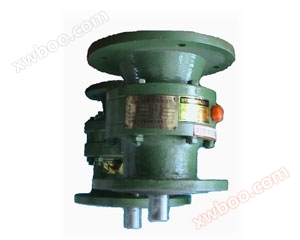
WB series micro cycloidal reducer
The WB series reducer has the characteristics of high transmission ratio, high efficiency, small size, light weight, durability, reliable use, long service life, and can be installed and used at any angle and direction. Suitable for deceleration and transmission devices in food machinery, printing machinery, textile machinery, rubber and plastic machinery, pharmaceutical machinery, ceramic machinery, and various industrial production lines.
1、 Micro reducer model, reduction ratio and its representation method
a. The single-stage reduction ratio models include WB65, WB85, WB100, WB120, and WB150. Their reduction ratios are 9, 11, 17, 23, 29, 35, 43, 59, 71, and 87, respectively.
b. There are models with dual reduction ratios, including WBE1065, WBE1285, and WBE1510. Their reduction ratios are: 121, 187, 289, 385, 473, 595, 731, 989, 1225, 1849.
2、 WB series first level micro cycloidal pinwheel reducer model specification selection parameters:
Model, specification, selection parameters of first level micro reducer
model |
Three phase motor (W) |
Single phase motor (W) |
DC servo motor (W) |
Brake motor (W) |
gear ratio |
Low speed shaft allowable torque N · m |
|||||||||
9 |
11 |
17 |
23 |
29 |
35 |
43 |
59 |
71 |
87 |
||||||
65 |
40 |
40※ |
○ |
○ |
○ |
○ |
○ |
○ |
25 |
||||||
60 |
60※ |
50 |
○ |
○ |
○ |
○ |
○ |
● |
|||||||
90 |
90※ |
○ |
○ |
○ |
○ |
● |
△ |
||||||||
120 |
○ |
○ |
○ |
● |
△ |
△ |
|||||||||
85 |
90 |
90▲ |
80 |
○ |
○ |
○ |
○ |
○ |
○ |
60 |
|||||
120 |
120▲ |
123 |
○ |
○ |
○ |
○ |
○ |
● |
|||||||
180 |
200 |
○ |
○ |
○ |
○ |
○ |
● |
△ |
|||||||
250 |
○ |
○ |
○ |
○ |
● |
△ |
△ |
||||||||
370 |
○ |
○ |
○ |
● |
△ |
△ |
△ |
||||||||
100 |
180 |
180★ |
185 |
200 |
○ |
○ |
○ |
○ |
○ |
○ |
○ |
○ |
120 |
||
250 |
250★ |
○ |
○ |
○ |
○ |
○ |
○ |
○ |
● |
||||||
370 |
370★ |
355 |
400 |
○ |
○ |
○ |
○ |
○ |
○ |
● |
△ |
||||
550 |
○ |
○ |
○ |
○ |
○ |
● |
△ |
△ |
|||||||
750 |
○ |
○ |
○ |
● |
△ |
△ |
△ |
△ |
|||||||
120 |
370 |
370★ |
355 |
400 |
○ |
○ |
○ |
○ |
○ |
○ |
○ |
● |
△ |
150 |
|
550 |
550★ |
550 |
○ |
○ |
○ |
○ |
○ |
● |
● |
△ |
|||||
750 |
750★ |
750 |
○ |
○ |
○ |
○ |
● |
△ |
△ |
△ |
△ |
||||
1100 |
○ |
○ |
○ |
● |
△ |
△ |
△ |
△ |
△ |
||||||
1500 |
○ |
○ |
● |
△ |
△ |
△ |
△ |
△ |
△ |
||||||
150 |
550 |
550★ |
○ |
○ |
○ |
○ |
○ |
○ |
○ |
○ |
● |
△ |
250 |
||
750 |
750★ |
750 |
○ |
○ |
○ |
○ |
○ |
○ |
○ |
● |
△ |
△ |
|||
1100 |
1100 |
○ |
○ |
○ |
○ |
○ |
● |
△ |
△ |
△ |
△ |
||||
1500 |
1500 |
○ |
○ |
○ |
● |
● |
△ |
△ |
△ |
△ |
△ |
||||
2200 |
3200 |
○ |
○ |
● |
△ |
△ |
△ |
△ |
△ |
△ |
△ |
||||
3000 |
3000 |
○ |
● |
△ |
△ |
△ |
△ |
△ |
△ |
△ |
△ |
||||
Output shaft speed (r/min) |
When using a four level motor (1400r/min) |
155 |
127 |
82 |
60 |
48 |
40 |
32 |
23 |
20 |
17 |
||||
When using a six level motor (950r/min) |
105 |
86 |
56 |
41 |
33 |
27 |
22 |
16 |
13 |
11 |
|||||

